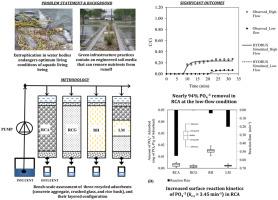Chemosphere ( IF 8.8 ) Pub Date : 2021-09-06 , DOI: 10.1016/j.chemosphere.2021.132152 Taufiqul Alam 1 , Juan César Bezares-Cruz 1 , Ahmed Mahmoud 2 , Kim D Jones 1

|
Excessive nitrate and orthophosphate carried by the stormwater runoff potentially lead to eutrophication in surface water bodies. Various green infrastructures are used that commonly consider the biological treatment of nutrients from the runoff. Due to the leaching and clogging complexities in biological mechanisms, the selection of high-flow, eco-friendly, and recycled adsorbents has been advocated to promote the physiochemical treatment of nutrients as an alternative. In this study, column experiments were conducted to investigate the transport, fate, adsorption equilibria, and reaction kinetics of nitrate (NO3–N) and orthophosphate (PO4–P) onto three recycled adsorbents - recycled concrete aggregate (RCA), recycled crushed glass (RCG), rice husks (RH), and a layered media (LM), under high and low-flow conditions. The non-reactive solute transport in columns was investigated through the bromide tracer test. The HYDRUS-1D model was used to estimate adsorption coefficients and reaction kinetics of pollutants in unsaturated media columns. Our results indicated the maximum superficial pore velocity (v = 4.40 cm/s) and dispersion (α = 2.50 cm) in RCA at the low-flow condition. Overall, NO3–N removal at the exhaustion was low in all columns, ranging between 1 and 25%. Conversely, orthophosphate removal was significant (p < 0.05) in RCA (≤94%) under low flow conditions with increased reaction kinetics (kr,d = 3.45 min−1, kr,s = 0.55 min−1) and enhanced adsorption capacity at saturation (qmax = 1.87E+05–2.33E+05 mg/kg). In conclusion, the dissolved-phase reaction kinetics (kr,d) played a significant role apart from the physisorption for the satisfactory removal of orthophosphate in RCA.
中文翻译:

使用循环吸附剂处理高流量和低流量雨水径流,模拟硝酸盐和正磷酸盐的迁移、归宿和去除动力学
雨水径流携带的过量硝酸盐和正磷酸盐可能导致地表水体富营养化。使用各种绿色基础设施,通常考虑对径流中的养分进行生物处理。由于生物机制中浸出和堵塞的复杂性,人们提倡选择高流量、环保和可回收的吸附剂,以促进营养物质的理化处理作为替代方案。在本研究中,进行柱实验以研究硝酸盐 (NO 3 –N) 和正磷酸盐 (PO 4-P) 到三种再生吸附剂上——再生混凝土骨料 (RCA)、再生碎玻璃 (RCG)、稻壳 (RH) 和分层介质 (LM),在高流量和低流量条件下。通过溴化物示踪剂测试研究了色谱柱中的非反应性溶质传输。HYDRUS-1D模型用于估计污染物在不饱和介质柱中的吸附系数和反应动力学。我们的结果表明在低流量条件下 RCA 中的最大表观孔隙速度 (v = 4.40 cm/s) 和分散 ( α = 2.50 cm)。总体而言,在所有塔中,耗尽时NO 3 -N 的去除率都较低,范围在 1% 到 25% 之间。相反,正磷酸盐的去除是显着的(p< 0.05) 在低流量条件下在 RCA (≤94%) 中增加反应动力学 (k r,d = 3.45 min -1 , k r,s = 0.55 min -1 ) 和饱和吸附能力增强 (q max = 1.87 E+05–2.33E+05 毫克/公斤)。总之,溶解相反应动力学 (k r,d ) 除了物理吸附之外,还对 RCA 中正磷酸盐的令人满意的去除起到了重要作用。



























 京公网安备 11010802027423号
京公网安备 11010802027423号